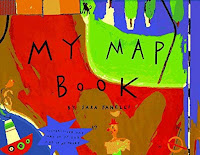 I went to the 'Playing With Poetry' session with A.F. Harrold at the Sydney Writers Festival last weekend and had a fabulous morning banging out some poetry in response to the provided prompts. The other joy, of course, was hearing the writing of the other attendees - one of whom was just 17 years old - what a talent!
I went to the 'Playing With Poetry' session with A.F. Harrold at the Sydney Writers Festival last weekend and had a fabulous morning banging out some poetry in response to the provided prompts. The other joy, of course, was hearing the writing of the other attendees - one of whom was just 17 years old - what a talent!I happily scooped the hours up for my Maintenance of Accreditation at Proficient (thank you SWF!) and thought some of the activities would be great in the classroom! If you see A.F. Harrold out and about in Australia - try to get your students to his workshops as he writes for young people and runs school workshops, in England.
Nursery Rhyme Lipograms
Writing an entire novel without the letter 'E' as Ernest Vincent Wright did with 'Gadsby,' would be quite a task, but a Nursery Rhyme? Way more feasible! Nursery Rhymes are not exactly common childhood fodder these days, so mind that not every student will be able to recall one - in the session we couldn't either so we did a quick brainstorm and shared ideas. Several of us ended up writing the same Nursery Rhyme but this was fun when it came to reading out our verse. This got me thinking about why the Nursery Rhyme worked for this activity - they're short, have a simple rhyme scheme, and utilise techniques like repetition. Students could possibly use the chorus from a favourite song.
1. Choose a Nursery Rhyme.
2. Decide which letter or vowel could be removed. Encourage students to challenge themselves - if there is only one 'U' in the entire Nursery Rhyme, for example, well that's no fun!
3. Write the Nursery Rhyme - give students the option of sticking closely to the original in rhyme and rhythm or keep some aspects if possible.
The Proverbial
Having fun with words can come from engaging with well known proverbs.
1. Choose a proverb.
2. Change one of the words.
3. Consider the impact of this change - perhaps laugh or consider the profoundness of the new 'proverb.'
4. Remember, don't put all of your enemies in the one basket.
'An Attempt at Exhausting a Place in...'
An Attempt at Exhausting a Place in London is described as part documentary, part poetry, part catalogue recording the events of a weekend in Hackney. The focus of 'An Attempt at Exhausting a Place in London' is to capture the small details of the moment. Recording, memorialising, appreciating what we would probably not notice.

1. Choose a location for a 15-minute writing sprint.
2. Give students the option of writing free verse or perhaps begin with a list poem to locate students in the concrete detail before they move to abstraction. It maybe that they begin with a list, then edit with a focus on adding a simile and a metaphor or another rhetorical device.
The Story of a Button
The last activity in the workshop involved an object. We all closed our eyes and were handed an object. It was amazing just how much story was inspired by a little, tiny button.
1. To begin, hand each student a button. Ask them to consider how it feels, what it looks like, where it may have originated.
2. Zoom in on the button, describe it in one sentence.
3. Where is the button located? Move from concrete to the imagination. Write about what the button is attached to in three sentences.
4. Zoom out again, consider who is wearing the item or where the item is located. Write six sentences.
It was a fabulous morning all in all. It never ceases to amaze me how a blank page becomes a piece of creative work in just moments (first draft, obviously!). If you are interested in seeing A.F. Harrold's wonderful work, visit his website here.



